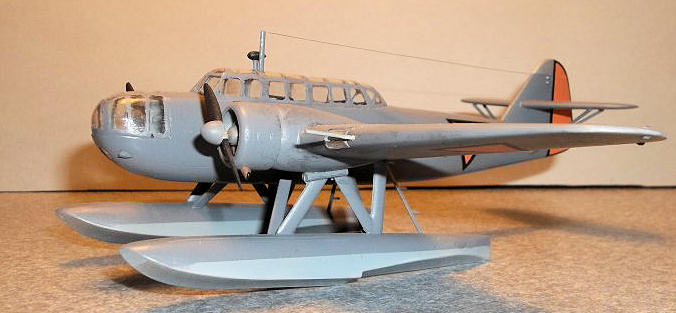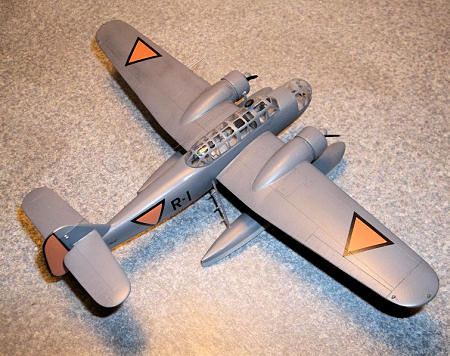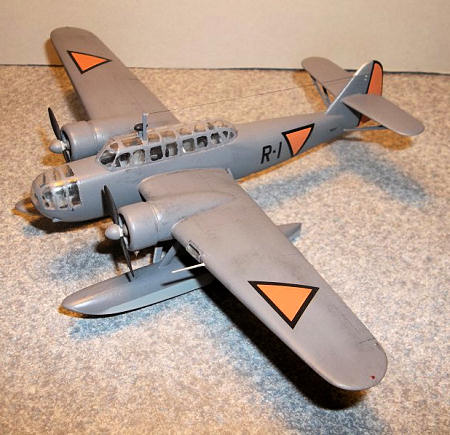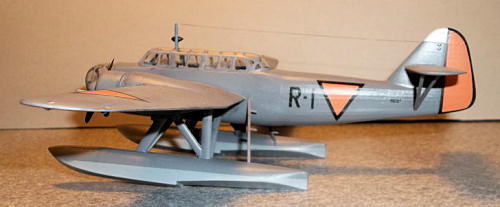MPM 1/72 Fokker T.VIIIW
|
KIT #: |
72080 |
|
PRICE: |
$ |
|
DECALS: |
Four Options |
|
REVIEWER: |
Brian Baker |
|
NOTES: |
Old kit, but still available on line. |

In response to a Marine Luchtvaartdienst requirement for a successor to the
Fokker T.IV floatplane, Fokker developed the T.VIIIW floatplane reconnaissance
bomber in 1938. This plane had several functions, including coastal patrol,
bombing, and torpedo attacks. Fourteen were produced before the German invasion
in 1940, a nd
the few survivors were evacuated to
France,
and later
England,
where they were used by No. 320 ( Dutch) squadron of Coastal Command until they
ran out of spare parts and were replaced by
Hudsons.
Those aircraft still on the production line or at the
factory were taken over by the Luftwaffe, and these were used for coastal patrol
over the
Mediterranean.
A number of an improved version were on order for
Finland,
but none of these was delivered, these being the ones the Germans appropriated.
At least one German example was tested with a fixed
landing gear.
Flying characteristics were good, and the plane was popular with
its crews.
nd
the few survivors were evacuated to
France,
and later
England,
where they were used by No. 320 ( Dutch) squadron of Coastal Command until they
ran out of spare parts and were replaced by
Hudsons.
Those aircraft still on the production line or at the
factory were taken over by the Luftwaffe, and these were used for coastal patrol
over the
Mediterranean.
A number of an improved version were on order for
Finland,
but none of these was delivered, these being the ones the Germans appropriated.
At least one German example was tested with a fixed
landing gear.
Flying characteristics were good, and the plane was popular with
its crews.
This kit has to date back to the late nineties, as I built my model in 1999.
It consists of approximately 48 parts molded in light
grey styrene, 5 resin parts, including engines and interior panel detail, 4
clear plastic parts, and about 28 PE parts, including cockpit details, control
balances, etc.
The parts are nicely detailed and there is very little flash.
Decals are included for four aircraft:
2 Dutch, one RAF, and one Luftwaffe.
An instrument panel is provided, printed on photo
negative film, to be cut out and glued to the PE panel.
Instructions are excellently done, with a history in Czech, French, German and
English.
Why not in Dutch I canít say.
Drawings are clear, and color information is easy to
figure out.
Color schemes are provided for all four aircraft, although the
camouflage patterns for the RAF and Luftwaffe versions are not complete.
 There are
absolutely no surprises in this kit.
The interior contains a lot of parts which need to be
prepared and painted before installation, but with a long greenhouse canopy, I
would advise doing some research and
trying to find some photos of the cockpit interior.
I wasnít able to do this, so my model was pretty much
straight out of the box. One weak point is the seats, which, except for the
pilotís, are represented by shapeless blobs which need some work to be converted
to real seats.
At least most of the details are in the kit, and these can be
seen through the clear cockpit canopy.
There are
absolutely no surprises in this kit.
The interior contains a lot of parts which need to be
prepared and painted before installation, but with a long greenhouse canopy, I
would advise doing some research and
trying to find some photos of the cockpit interior.
I wasnít able to do this, so my model was pretty much
straight out of the box. One weak point is the seats, which, except for the
pilotís, are represented by shapeless blobs which need some work to be converted
to real seats.
At least most of the details are in the kit, and these can be
seen through the clear cockpit canopy.
The rest of the kit goes together easily, and
although there are no mounting tabs, none are really needed.
Very little filler is required, although I would suggest
adding some weight to the nose. Probably the best place to do this would be the
forward sections of the floats, as the cockpit leaves very little room for this,
and the engines are a little too far back toward the CG.
Building a beaching dolly would be another solution to
this problem if you can find a photograph of one, but balance will still be a
problem. Everything
on this kit fits nicely, and very little filler is needed.
The struts are simple to install, although I would
suggest that if you are building a ďone colorĒ version, attach everything to the
airframe before you start painting.
If the German or British version is being done, donít
attach the floats until after painting the airframe. This makes things much
easier. Be sure to do your research, as there were detail differences between
the Dutch British, and German aircraft. Check the photos to make sure.
 There
are a number of sources of information on this plane, and accounts vary as to
the actual colors. British and German aircraft
present no
problems, but the Dutch versions were either overall aluminum or a medium grey
with some aluminum trim.
The kit instructions say silver, while the Profile
Publication shows a medium grey color overall.
I chose the grey. The decals were excellent, and the
plane is quite colorful with the grey with orange insignias.
The planes were probably kept in pretty pristine
condition up until the beginning of the war, so a lot of weathering is probably
not necessary except for the British
and Luftwaffe versions.
There
are a number of sources of information on this plane, and accounts vary as to
the actual colors. British and German aircraft
present no
problems, but the Dutch versions were either overall aluminum or a medium grey
with some aluminum trim.
The kit instructions say silver, while the Profile
Publication shows a medium grey color overall.
I chose the grey. The decals were excellent, and the
plane is quite colorful with the grey with orange insignias.
The planes were probably kept in pretty pristine
condition up until the beginning of the war, so a lot of weathering is probably
not necessary except for the British
and Luftwaffe versions.
This kit isnít the only one in town: the
Burns lists a number of kits, including CMK/CMR,
Czechmasters, Model Masters, OíNeil, Replica, Rudel, Wings, MPM, and WK, all in
1/72 scale, but the MPM is the only one Iíve seen. I donít know the production
status of this kit, but I googled it and it appears that there are quite a few
listed for sale from various sources. This kit is worth getting, and it was a
fun build.
Get one and enjoy.
 There
are basically three reference works available on this aircraft. The Profile No.
176 on the T-VIII is quite good.
William Greenís little book,
Floatplanes,
Vol. 7, has a good account of the typeís service career.
Harleyfordís Fokker, the Man and the Aircraft, also has
good material. There are undoubtedly more, but these were all I had.
There
are basically three reference works available on this aircraft. The Profile No.
176 on the T-VIII is quite good.
William Greenís little book,
Floatplanes,
Vol. 7, has a good account of the typeís service career.
Harleyfordís Fokker, the Man and the Aircraft, also has
good material. There are undoubtedly more, but these were all I had.
Brian Baker
June 2012If you would like your product reviewed fairly and
fairly quickly , please
contact
the editor
or see other details in the
Note to
Contributors.
Back to the Main Page
Back to the Review Index Page


 nd
the few survivors were evacuated to
nd
the few survivors were evacuated to  There are
absolutely no surprises in this kit.
The interior contains a lot of parts which need to be
prepared and painted before installation, but with a long greenhouse canopy, I
would advise doing some research and
trying to find some photos of the cockpit interior.
I wasnít able to do this, so my model was pretty much
straight out of the box. One weak point is the seats, which, except for the
pilotís, are represented by shapeless blobs which need some work to be converted
to real seats.
At least most of the details are in the kit, and these can be
seen through the clear cockpit canopy.
There are
absolutely no surprises in this kit.
The interior contains a lot of parts which need to be
prepared and painted before installation, but with a long greenhouse canopy, I
would advise doing some research and
trying to find some photos of the cockpit interior.
I wasnít able to do this, so my model was pretty much
straight out of the box. One weak point is the seats, which, except for the
pilotís, are represented by shapeless blobs which need some work to be converted
to real seats.
At least most of the details are in the kit, and these can be
seen through the clear cockpit canopy.
